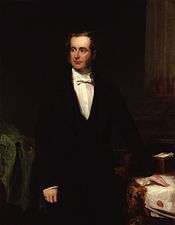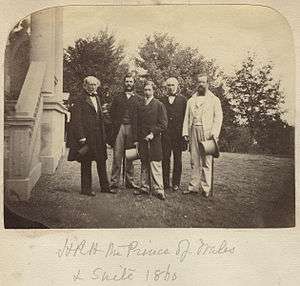Henry Pelham-Clinton, 5th Duke of Newcastle
| His Grace The Duke of Newcastle KG PC | |
|---|---|
 | |
| Secretary of State for War and the Colonies | |
|
In office 28 December 1852 – 10 June 1854 | |
| Monarch | Victoria |
| Prime Minister | The Earl of Aberdeen |
| Preceded by | Sir John Pakington, Bt |
| Succeeded by | Office abolished |
| Secretary of State for War | |
|
In office 12 June 1854 – 30 January 1855 | |
| Monarch | Victoria |
| Prime Minister | The Earl of Aberdeen |
| Preceded by | New office |
| Succeeded by | The Lord Panmure |
| Secretary of State for the Colonies | |
|
In office 18 June 1859 – 7 April 1864 | |
| Monarch | Victoria |
| Prime Minister | The Viscount Palmerston |
| Preceded by | Sir Edward Lytton, Bt |
| Succeeded by | Edward Cardwell |
| Personal details | |
| Born | 22 May 1811 |
| Died | 18 October 1864 (aged 53) |
| Nationality | British |
| Political party |
Tory Peelite Liberal |
| Spouse(s) | Lady Susan Douglas-Hamilton (1814–1889) |
| Alma mater | University of Oxford |
Henry Pelham Fiennes Pelham-Clinton, 5th Duke of Newcastle-under-Lyne KG, PC (22 May 1811 – 18 October 1864), styled Earl of Lincoln before 1851, was a British politician.
Background
Newcastle was the son of Henry Pelham-Clinton, 4th Duke of Newcastle-under-Lyne, by his wife Georgina Elizabeth, daughter of Edward Miller-Mundy. He was educated at Eton and Christ Church, Oxford, where he took his B.A. degree in 1832, and was created a D.C.L. in 1863.[1]
Political career
Newcastle was returned to Parliament for South Nottinghamshire in 1832, a seat he held until 1846, and then represented Falkirk Burghs until 1851, when he succeeded his father in the dukedom. Initially a Tory, he served under Sir Robert Peel as First Commissioner of Works from 1841 to 1846 and as Chief Secretary for Ireland in 1846. He was admitted to the British Privy Council in 1841, and to the Irish Privy Council on 14 February 1846.[1]
Newcastle joined the Peelites in 1846, and held office in Lord Aberdeen's coalition government as Secretary of State for War and the Colonies between 1852 and 1852, and as Secretary of State for War and Secretary at War between 12 June 1854 and 1 February 1855, when he resigned over the Crimean War.[1]
From 18 June 1859 to April 1864, he served as Secretary of State for the Colonies in Lord Palmerston's Liberal administration. In 1860, while holding this office, he went to Canada and the United States, in company with the Prince of Wales. Apart from his political career he also held the honorary posts of Lord Lieutenant of Nottinghamshire from 1857 to 1864 and Lord Warden of the Stannaries from 1862 to 1864. He was made a Knight of the Garter on 17 December 1860.[1]
Lord Lincoln was a member of the Canterbury Association from 27 March 1848. Upon succeeding to the dukedom, he joined the association's management committee on 29 January 1851.[2] In 1849, the chief surveyor of the Canterbury Association, Joseph Thomas, named the future town of Lincoln in New Zealand after him. The town's university was in turn also named after Lord Lincoln.[2][3]
Family
Newcastle married Lady Susan (9 June 1814 – 28 November 1889), daughter of Alexander Hamilton, 10th Duke of Hamilton, on 27 November 1832. They had five children:
- Henry Pelham-Clinton, 6th Duke of Newcastle-under-Lyne (25 January 1834 – 22 February 1879), who married Henrietta Adela Hope (11 April 1843 – 8 May 1913) on 11 February 1861 and had five children.
- Lord Edward William Pelham-Clinton (11 August 1836 – 9 July 1907), who married Matilda Jane Cradock-Hartopp (died 23 October 1892) on 22 August 1865.
- Lady Susan Charlotte Catherine Pelham-Clinton (7 April 1839 – 6 September 1875), who married Lord Adolphus Vane-Tempest (2 July 1825 – 11 June 1864) on 23 April 1860. She was a mistress of Edward VII of England when he was Prince of Wales.
- Lord Arthur Pelham-Clinton (23 June 1840 – 18 June 1870) who died, possibly by suicide, after being charged in the Boulton and Park case.[4]
- Lord Albert Sidney Pelham-Clinton (22 December 1845 – 1 March 1884), who married Mrs Frances Evelyn Stotherd on 17 November 1870; they were divorced in 1877.
The marriage was unhappy and the Duke and Duchess were divorced in 1850, after a considerable scandal in which the Duchess eloped with Horatio Walpole, Lord Walpole, and had an illegitimate child by him. Newcastle died in October 1864, aged 53, and was succeeded in the dukedom by his eldest son, Henry.
His papers are now held at Manuscripts and Special Collections, The University of Nottingham.
Titles and styles from birth to death

- Earl of Lincoln (1811–1832)
- Earl of Lincoln, MP (1832–1841)
- The Rt. Hon. The Earl of Lincoln, PC, MP (1841–1851)
- His Grace The Duke of Newcastle-under-Lyne, PC (1851–1860)
- His Grace The Duke of Newcastle-under-Lyne, KG, PC (1860–1864)
See also
References
- 1 2 3 4 Boase 1887.
- 1 2 Blain, Rev. Michael (2007). The Canterbury Association (1848–1852): A Study of Its Members' Connections (PDF). Christchurch: Project Canterbury. pp. 66–68. Retrieved 21 March 2013.
- ↑ Hight, James; C. R. Straubel (1957). A History of Canterbury. Volume I : to 1854. Christchurch: Whitcombe and Tombs Ltd. p. 120.
- ↑ Robert Aldrich, Garry Wotherspoon, "Who's who in gay and lesbian history: from antiquity to World War II", Routledge, 2001, ISBN 0-415-15982-2, p.66
- Attribution
![]() This article incorporates text from a publication now in the public domain: Boase, George Clement (1887). "Clinton, Henry Pelham Fiennes Pelham (1811-1864)". In Stephen, Leslie. Dictionary of National Biography. 11. London: Smith, Elder & Co. pp. 98–99.
This article incorporates text from a publication now in the public domain: Boase, George Clement (1887). "Clinton, Henry Pelham Fiennes Pelham (1811-1864)". In Stephen, Leslie. Dictionary of National Biography. 11. London: Smith, Elder & Co. pp. 98–99.
External links
- Hansard 1803–2005: contributions in Parliament by the Duke of Newcastle
- Biography of the 5th Duke, with links to online catalogues, from Manuscripts and Special Collections at The University of Nottingham
- "Archival material relating to Henry Pelham-Clinton, 5th Duke of Newcastle". UK National Archives.
- Pictures of the Duke of Newcastle at the National Portrait Gallery
- Leigh Rayment's Peerage Pages
- Leigh Rayment's Historical List of MPs